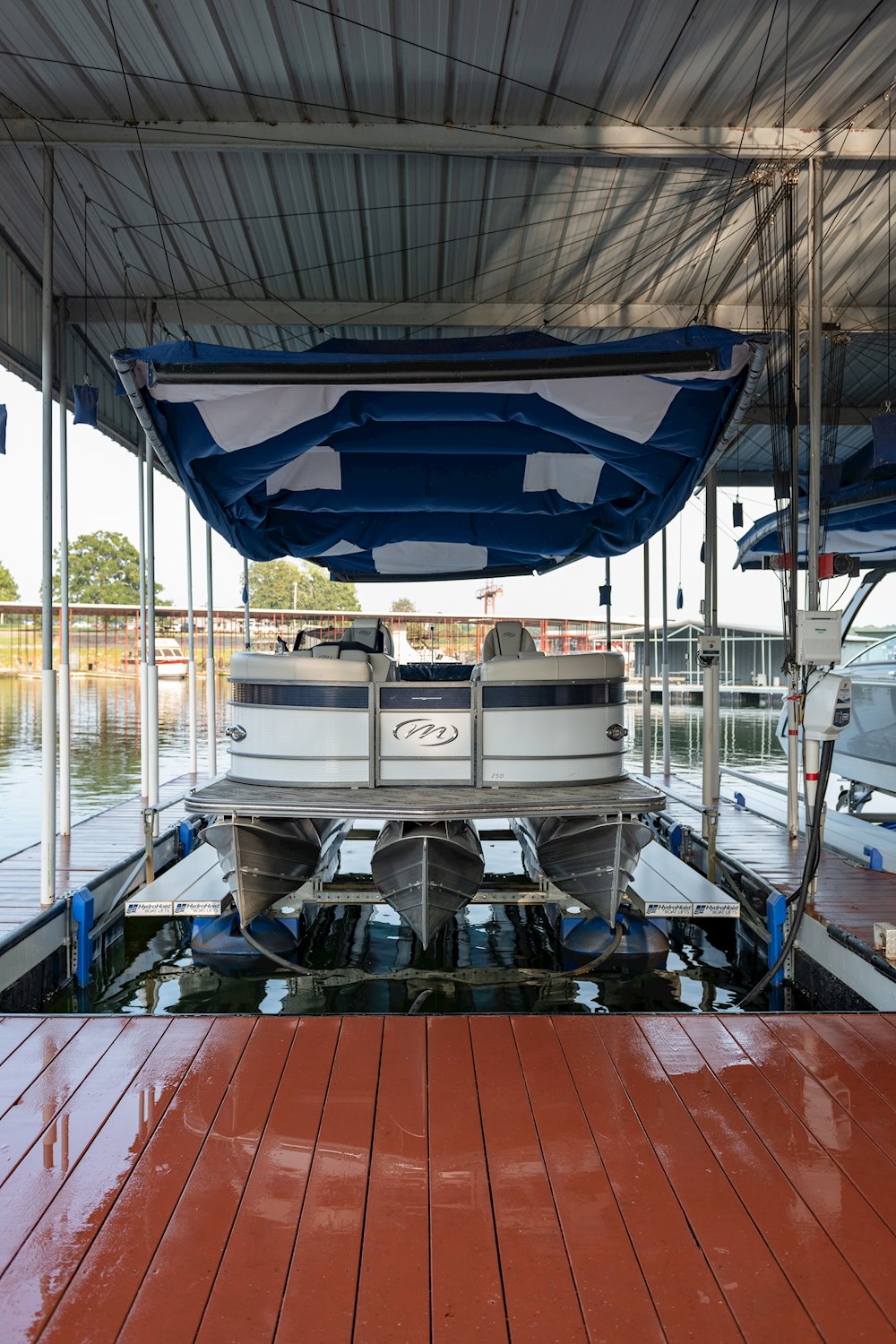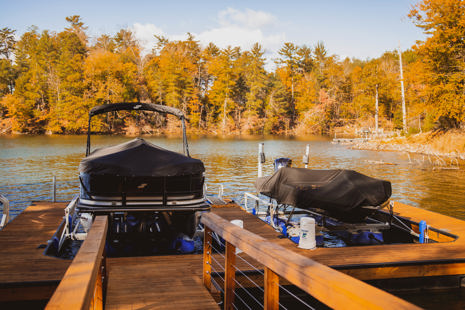A floating pontoon boat lift is a game-changing solution for protecting and storing pontoon boats. By keeping your watercraft out of the water when not in use, these innovative docking solutions protect your vessel from corrosion, rough water damage, and intake fouling associated with marine growth. And, when it’s time to get back on the water, a simple switch lowers your boat for the utmost launching convenience.
If you’re looking to elevate your boating experience, adding a floating boat lift to your docking system is one of the best decisions you can make.

Introduction to Floating Pontoon Boat Lifts
HydroHoist designs floating pontoon boat lifts to fit today’s larger, more powerful vessels. Their longer, wider design provides a more stable platform for lifting pontoons, while specially designed bunks and rails offer better support and guidance when entering and exiting the lift.
Floating lifts for pontoon boats also offer the following benefits:
- Versatility: We design our floating boat hoists to adapt to various waterfront conditions, with some models capable of operating in waters as shallow as four feet. These free-floating lifts are compatible with virtually all dock systems and slip configurations and are adjustable to nearly all boat styles and hull designs, including V-hull, wake, and pontoon boats.
- Ease of use: HydroHoist floating boat lifts come with a standard control package that provides the fastest launch time in the industry by simply flipping a switch and turning the handle. You can upgrade to a push-button or remote control system to further minimize docking rituals and maximize your time on the water.
- Durability: We construct our lifts for pontoon boats with a marine-grade aluminum frame and rugged rotomolded polyethylene tanks, capable of supporting vessels ranging from 4,400 to 25,000 pounds. Rotational molding is a production process that involves heating a hollow mold filled with plastic resin and rotating it on multiple axes. According to RotoMold USA, “The result is a product that contains seamless parts with a uniform wall thickness with more material in corners to absorb shocks and stresses where they occur most (RotoMoldUSA, n.d.).”
In addition to protecting boats from the elements, a quality boat lift system streamlines maintenance tasks by providing easy access to the watercraft’s hull, propeller, and other critical components. This lets owners easily perform routine inspections, cleaning, and repairs, enabling them to catch and prevent potential issues early.
Types of Lifts for Pontoon Boats
Pontoon boat lifts primarily fall under two categories: fixed and floating. Permanently anchored to the shore or dock, fixed lifts typically offer the stability required by heavier vessels. These docking solutions use different lifting mechanisms, including a system of cables, pulleys, and winches, electric screw drives, and hydraulic pumps and cylinders.
On the other hand, floating boat lifts use floatation tanks to lift vessels out of the water, making them ideal for shorelines with fluctuating water levels. HydroHoist’s floating pontoon lifts use air pressure and water displacement to raise and lower boats. This lifting system ensures a smooth and steady operation, preventing sudden movements that could damage the watercraft or the lift. This level of control is particularly crucial when dealing with larger vessels, making a hydro pneumatic boat lift the ideal solution for pontoon owners.
Let’s take a closer look at these innovative docking solutions from HydroHoist:
- UltraLift Series: The UltraLift Series also features a heavy-duty hull support system capable of supporting boats ranging from 5,000 to 9,000 pounds. Its innovative design keeps all steel parts above the waterline, preventing corrosion, marine growth, and anything else the elements can throw at them.
- HarborHoist H2: This premium floating boat lift combines cutting-edge engineering and design with the ultimate versatility and ease of use to provide owners with a reliable and efficient way to protect and store their boats. The H2’s level-lifting frame ensures your boat is always lifted evenly and securely, protecting your boat from damage. Meanwhile, you can mount anti-slip walkways running the full length of the lift on top of the floatation tanks, providing easy and safe access to your boat.
Contact your local HydroHoist dealer today to learn more about the best protection for your pontoon boat.
How to Choose the Best Boat Lift for Your Pontoon
The perfect pontoon boat lift isn’t necessarily the one with the most advanced features; it’s the system that complements your vessel, needs, and lifestyle. Here are the primary factors to consider when choosing a boat lift:
- Boat size and weight: Ensure the lift can support the weight of your fully loaded boat, including any gear typically stored onboard. We recommend a lift with a capacity 20%–25% more than your watercraft’s wet weight. The lift should also be wide and deep enough to cradle the pontoons.
- Waterfront conditions: Consider the water depth, water level fluctuations, traffic, and available space in your docking area. This will let you know whether a fixed, dock-mounted, or shallow water lift suits your environment.
- Budget: Set a realistic budget without compromising your primary needs. A quality pontoon boat lift is an investment that virtually pays for itself by protecting your vessel and preserving its value.
Contact us today for expert advice on choosing the optimal boat lift for your specific requirements.
Installation Guide for Floating Pontoon Boat Lifts
While some DIY-savvy individuals might consider installing a boat lift themselves, we recommend leaving this task to authorized professionals. Improper assembly and installation could result in personal injury, damage to the lift, boat, or dock, or void applicable warranties. With that said, here’s an overview of the process and a few tips to make installation as seamless as possible:
Preparation:
- Check local regulations and obtain the necessary permits for installing a boat lift. In Florida, for example, the Department of Environmental Protection outlines a general permit process for floating vessel platforms and boat lifts (Florida Department of Environmental Protection, n.d.). Generally, if you’re installing a dock in or over navigable areas, you will likely need a permit.
- Determine the assembly location (remote or on-site) and the equipment required to build, transport, and launch the lift safely.
Assembly:
- Gather all required tools and equipment, including wrenches, bolts, gloves, and safety glasses.
- Ensure the assembly surface is flat and level. Ideally, you should assemble on a trailer. While a flatbed is preferred, a boat trailer with planks across the frame will work.
Installation:
- Position the lift in the desired location and secure it using the appropriate anchors or mooring points. Test the lift operation by raising and lowering it without the boat.
- Once the lift is in place and you’ve inspected the connections, perform a load test with the pontoon boat to ensure it operates smoothly.
For reference, the Light Series HarborHoist lift takes 8 to 12 man-hours to assemble on average. Contact your local HydroHoist dealer today for more information.
Maintenance and Care for Pontoon Boat Lifts
At HydroHoist, we take pride in providing the most advanced, easiest-to-use, and lowest-maintenance boat lift systems to the market. Below are some general guidelines to keep them that way:
- Routine maintenance: Follow the manufacturer’s recommendations for cleaning, lubrication, and inspection, paying attention to signs of wear, damage, and loose connections.
- Cleaning: Keep your dock and surrounding areas clean and clear. Debris and clutter can impede the lift’s smooth operation.
- Seasonal considerations: Be mindful of seasonal factors and take proactive measures accordingly. For areas with freezing temperatures, for instance, we recommend removing your lift from the water and draining water from the floats to prevent freezing and damage.
If you encounter any issues with your boat lift, contact your local dealer immediately.
References:
- RotoMoldUSA (n.d.) What is Rotational Molding? Retrieved from https://rotomoldusa.com/rotomold/#:~:text=Rotational%20molding%2C%20rotomolding%2C%20rotomold%20or,slowly%2C%20both%20vertically%20and%20horizontally.
- Florida Department of Environmental Protection (n.d.). Dock Permitting in Florida. Retrieved from https://floridadep.gov/sites/default/files/SWD_Dock%20Permitting%20in%20Florida-D5_FINAL_0.pdf
FAQs
"What type of lift is best for a pontoon boat?
The best type of lift for a pontoon boat is a floating pontoon boat lift, which is specifically designed to support the unique shape and weight of pontoon boats. Locate a dealer in your area to explore the best boat lift options tailored to your boat and waterfront needs: boatlift.com/find-a-dealer/
What is the difference between a boat lift and a pontoon lift?
A boat lift is a general term that refers to any type of lift that raises and lowers a boat out of the water, while a pontoon lift is a specific type of lift designed for pontoon boats. Pontoon lifts are typically wider and more stable than traditional boat lifts to accommodate the shape and weight of pontoons.
Are pontoon boats hard to dock?
Due to their flat hull and wide beam, pontoon boats can be more challenging to dock than traditional V-hull boats. However, with the right docking system and a little practice, docking a pontoon boat can be made easy.
How long can you leave a boat in water?
The length of time you can leave a boat in the water depends on various factors, including the type of boat, the water conditions, and its ongoing maintenance. In general, it's recommended to remove your boat from the water every 3-6 months to perform maintenance and inspections and store it on a lift during the off-season to prevent damage and corrosion."



